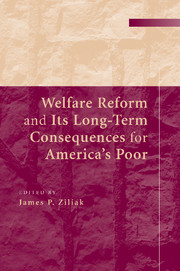Book contents
- Frontmatter
- Contents
- Contributors
- Preface
- Introduction
- 1 What We Know, What We Don't Know, and What We Need to Know about Welfare Reform
- 2 Welfare Reform and the Level and Composition of Income
- 3 How Have Expansions in the Earned Income Tax Credit Affected Family Expenditures?
- 4 How Families Are Doing Nine Years after Welfare Reform: 2005 Evidence from the Three-City Study
- 5 The Impact of Welfare Reform on Leaver Characteristics, Employment, and Recidivism
- 6 A Reexamination of the Impact of Welfare Reform on Health Insurance Among Less-Skilled Women
- 7 How Welfare Policies Affect Child and Adolescent School Performance: Investigating Pathways of Influence with Experimental Data
- 8 The Effects of Welfare and Child Support Policies on the Incidence of Marriage Following a Nonmarital Birth
- 9 Welfare Reform and Health among the Children of Immigrants
- 10 Mismatches and Unmet Need: Access to Social Services in Urban and Rural America
- Index
Introduction
Published online by Cambridge University Press: 21 January 2010
- Frontmatter
- Contents
- Contributors
- Preface
- Introduction
- 1 What We Know, What We Don't Know, and What We Need to Know about Welfare Reform
- 2 Welfare Reform and the Level and Composition of Income
- 3 How Have Expansions in the Earned Income Tax Credit Affected Family Expenditures?
- 4 How Families Are Doing Nine Years after Welfare Reform: 2005 Evidence from the Three-City Study
- 5 The Impact of Welfare Reform on Leaver Characteristics, Employment, and Recidivism
- 6 A Reexamination of the Impact of Welfare Reform on Health Insurance Among Less-Skilled Women
- 7 How Welfare Policies Affect Child and Adolescent School Performance: Investigating Pathways of Influence with Experimental Data
- 8 The Effects of Welfare and Child Support Policies on the Incidence of Marriage Following a Nonmarital Birth
- 9 Welfare Reform and Health among the Children of Immigrants
- 10 Mismatches and Unmet Need: Access to Social Services in Urban and Rural America
- Index
Summary
Two decades of federal and state demonstration projects and experiments with cash welfare in the United States culminated with the passage of the Personal Responsibility and Work Opportunity Reconciliation Act of 1996 (PRWORA). PRWORA, aka welfare reform, is widely viewed as the most fundamental reform to the U.S. social safety net since the New Deal by its dismantling of the major cash entitlement program Aid to Families with Dependent Children (AFDC) and replacement with the nonentitlement block grant program Temporary Assistance for Needy Families (TANF). Ten years after reform, a host of unanswered questions remain on the well-being of low-income families: Are labor-market earnings and total incomes higher, and are the effects of the reform the same across the income distribution? Did welfare reform and the concomitant expansions in the Earned Income Tax Credit (EITC) foster lasting transitions from welfare to work? What impact did these policy reforms have on household consumption and child outcomes? Did welfare reform affect health insurance and health outcomes for adults and children, and were there differential effects between immigrant and native populations? Did welfare reform, which encouraged the formation of two-parent families, succeed in increasing marriage? The 10 chapters in this book bring together leading poverty scholars to address these and many related questions on the longer-term consequences of welfare reform for America's poor.
Setting the Context: The Pre–Welfare Reform Era
Momentum for welfare reform had been building for the better part of two decades prior to its passage.
- Type
- Chapter
- Information
- Publisher: Cambridge University PressPrint publication year: 2009

